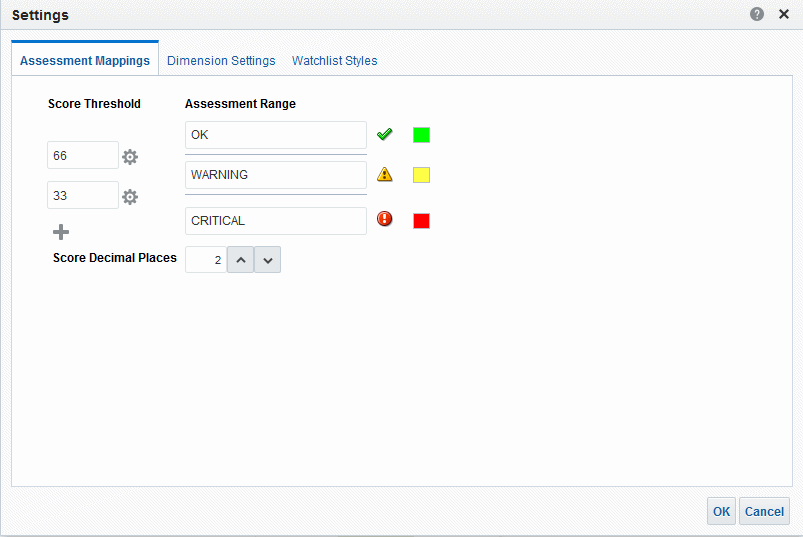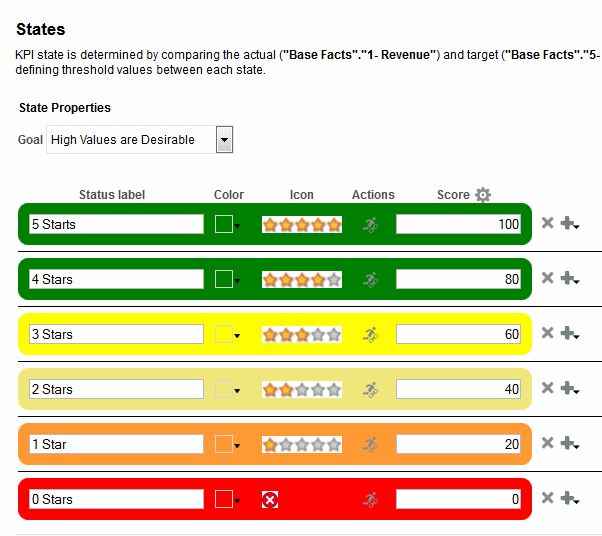Understand Initiative or Objective Performance Assessment
You can view initiative or objective performance assessments to get an overall view of a family of initiatives or objectives.
Oracle Business Intelligence assesses the performance of an initiative or objective by aggregating the assessments of its children. In the process, it uses:
-
Scorecard assessment mappings that you define. See About Assessment Mappings.
-
Assessment formulas (such as Weighted or Best Case) assigned to all objectives and initiatives. The assessment formulas include:
-
Worst case — Specifies that the status of the worst performing child KPI or objective is to be used.
-
Best case — Specifies that the status of the best performing child KPI or objective is to be used.
-
Most Frequent (Worst Case) — Specifies that, if half the child KPIs and objectives have high performance and half have low performance, then use the status of the worst performing child KPI or objective.
-
Most Frequent (Best Case) — Specifies that, if half the child KPIs and objectives have high performance and half have low performance, then use the status of the best performing child KPI or objective.
-
Weighted — Specifies to use a weighted average based on the weights you have assigned to the child KPIs and objectives. See Assign Weights to Child Objectives, Initiatives and KPIs.
If a child KPI has no data, it will not be included in the aggregation. Instead, its weight will be distributed among the other child KPIs and objectives.
You assign assessment formulas when you create an objective or initiative. See Create Objectives or Create Initiatives.
-
-
Weights that you assign to child initiatives, objectives, and KPIs (but only if the parent's assessment rule is set to Weighted) to identify the extent to which each child contributes to the overall performance of the parent. See Assign Weights to Child Objectives, Initiatives and KPIs.
See Example of Determining the Performance Assessment for an Objective Based on Child Objectives and Example of Determining the Performance Assessment for an Objective Based on a Child KPI.
About Assessment Mappings
Assessment mappings are the score thresholds and assessment ranges that Oracle Business Intelligence uses to assess the performance of objectives and initiatives.
Oracle Business Intelligence uses these score thresholds and assessment ranges to:
-
Determine the status and score of an objective or initiative based on the aggregation of the assessments of its children.
If the assessment formula of an objective or initiative is Best Case, Worst Case, Most Frequent (Worst Case), or Most Frequent (Best Case), the score will be one of the defined score thresholds, for example, 0, 33, or 66. If the assessment formula is Weighted, the score is computed based on the weights assigned to the children.
-
Map the KPI scores of KPIs that are used to measure the progress of initiatives and objectives to scorecard scores so that they can be used to measure the performance of the objectives or initiatives.
The illustration shows an example of score thresholds falling in specific assessment ranges. The assessment ranges are defined as follows:
-
67 to 100 falls in the OK assessment range
-
34 to 66 falls in the Warning assessment range
-
0 to 33 falls in the Critical assessment range
See Understand Initiative or Objective Performance Assessment for additional information on initiative and objective performance assessment.
See Define Assessment Mappings for Scorecards for how to define assessment mappings.
Example of Determining the Performance Assessment for an Objective Based on Child Objectives
Child objectives can help calculate a performance assessment.
Suppose the following about an objective named Improve Financial Results:
-
It has an assessment rule of Worst Case.
-
The assessment mappings defined for the scorecard that contains the objective are the same as those in About Assessment Mappings.
-
It has the following two child objectives:
-
Increase Sales, whose status is Critical and score is 0.
-
Reduce Cost, whose status is Warning and score is 50.
-
In this case, the performance assessment of the Improve Financial Results objective would be the status and score of the child with the worst status and score, that is, Increase Sales, which has a scorecard status of Critical and a score of 0.
Example of Determining the Performance Assessment for an Objective Based on a Child KPI
You can use child KPIs to assess performance.
Suppose the following about an objective named Enhance Stockholder Satisfaction:
-
It has an assessment formula of Best Case.
-
The assessment mappings defined for the scorecard that contains the objective are the same as those in the illustration.
-
It has a child KPI named Revenue KPI, whose scorecard status is OK and score is 66.
Revenue KPI has a KPI status of 4 Stars and score of 80 based on the following KPI thresholds and scores displayed in the illustration:
When Revenue KPI was added to the Enhance Stockholder Satisfaction objective, Oracle Business Intelligence mapped the KPI score to a scorecard score so that it could be used to measure the performance of the objective. Since the KPI score of 80 fell in the scorecard assessment range of 66 to 100, it mapped to a scorecard score of 66 and status of OK.
In this case, the performance assessment of the Enhanced Stockholder Satisfaction objective would be the status and score of the child with the best status and score, that is, Revenue KPI (in this case the only child), which has a scorecard status of OK and a score of 66.

